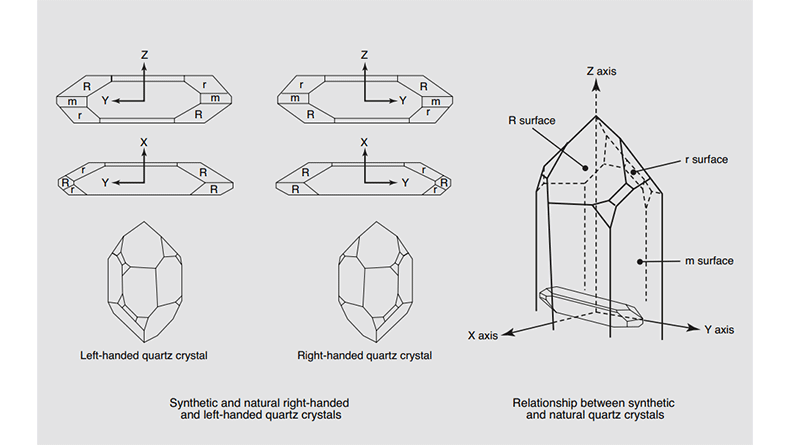Synthetic Quartz Crystal
Technical Terms
Terms and Definitions
We will introduce the main terms used for Synthetic Quartz Crystal.
| Synthetic Quartz Crystal | A single crystal grown using the hydrothermal synthesis method. |
|---|---|
| As-Grown Quartz Crystal | A synthetic quartz crystal grown naturally with no processing. |
| Lumbered Quartz Crystal | A synthetic quartz crystal with the X and Z surfaces processed according to specified dimensions and angles using a diamond wheel #80. |
| Y-bar Synthetic Quartz Crystal | A synthetic quartz crystal grown by using a bar-like seed crystal elongated in the Y-axis direction. |
| Z-plate Synthetic Quartz Crystal | A synthetic quartz crystal grown by using a plate-like seed crystal with a Y-axis direction length and X-axis direction width. |
| Inclusion | A general term for solid constituents (inclusions) that exist in synthetic quartz crystal; they can be observed when light is scattered through a liquid with a refractive index that is close to that of the synthetic quartz crystal. Main inclusions are acmite and emeleusite. They are generated by the chemical reaction of Fe within an autoclave and synthetic quartz crystal growth frame, Na from a solution, SiO2 of a material, etc. at high temperature and under high pressure. |
| Twins | Crystallographically, taking into account specific facets or axes two or more crystals are symmetrically joined to one crystal. Almost all twin crystals that are generated as synthetic quartz crystals are electrical ones, and electrical twin crystals affect the shape of the synthetic quartz crystal. They can easily be identified visually. |
| Right-handed and Left-handed Quartz Crystals | Crystals are divided into two types: right-handed and left-handed. A difference in optical rotation creates the 2 types, but their physical properties are identical. Therefore, by cutting at the correct angle, the difference does not affect the characteristics of a crystal oscillator. Generally right-handed quartz crystals are used in manufacture. |
| Zone | A zone with a crystal that has grown from a seed crystal at its core. There are Z, +X, -X, and S zones. |
| Infrared Absorption Coefficient α |
This value measured with an infrared spectrophotometer is adopted as the infrared absorption coefficient α of a synthetic quartz crystal. The value is based on the absorption characteristic of the OH radical of a synthetic quartz crystal that is around 3,800 to 3,000 cm-1 of the infrared transmittance curve. Generally, absorption coefficients with wave numbers 3585, 3500, and 3410 cm-1 have been adopted. (As is usual practice, an infrared Q value is also described for reference.) |
| Etch Channel | Tubular cavities generated along linear defects in a crystal when the crystal is etched. When the processing of a crystal piece for manufacturing a tuning fork-type crystal oscillator or a reversed mesa-type involves etching, a synthetic quartz crystal with a low etch channel density is particularly suitable. |

Properties of Quartz Crystal
Constituent : SiO2
Crystal System : Trigonal system
Crystallographic Group : D3(32)
Lattice Constant : a=4.9027+70×10-6(T-18)kX
c=5.3934+47×10-6(T-18)kX
1kX=1.002063±0.000007Å
Density : 2.649g/cm³
α-β Phase Transition Temperature : 573℃
Synthetic Quartz Crystal
